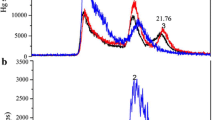Abstract
This article is based on data on the levels of metals (Cd, Zn, Cu) and metallothionein (MT) determined radiochemically with203Hg in renal cortex and liver of 137 autopsy cases. From this number, for 23 cases, the gel filtration of the cytoplasmic fraction of the organs was performed.
The molar content of metals in the MT fraction (Sephadex G-50) amounted to 46.9, 50.2, and 2.0% for Cd, Zn, and Cu in renal cortex, respectively, and to 8.3, 83.6, and 9.1% for Cd, Zn, and Cu in the liver, respectively. In parallel with the increase of Cd and MT in renal cortex, increasing saturation was found of the MT fraction by Cd, occurring at the expense of Zn and Cu. Equimolar amounts of Cd and Zn in the MT fraction are found at Cd level of 0.5 μmol Cd/g wet wt of renal cortex. In the liver, analogous dependency (elevation of %Zn, depression of %Cd and %Cu) were observed in relation to Zn and MT levels in this organ.
The basic level of Zn (not bound with MT) was estimated at 0.5 μmol/g for both renal cortex and liver. A deficit of non-MT Zn in kidneys is proposed as an alternative mechanism of toxic Cd action.
Similar content being viewed by others
References
M. Margoshes and B. L. Valee, A cadmium protein from equine kidney cortex,J. Am. Chem. Soc. 79, 4813–1814 (1957).
J. H. R. Kägi, M. Vašak, K. Lerch, D. E. O. Gilg, P. Hunziker, W. R. Bernhard, et al., Structure of mammalian metallothionein,Environ. Health Perspect. 54, 93–103 (1984).
A. J. Zelazowski and J. K. Piotrowski, A modified procedure for determination of metallothionein-like proteins in animal tissues,Acta Biochim. Polon. 24, 325–333 (1977).
C. Dorian and C. D. Klaassen, Protection by Zn-metallothionein (ZnMT) against cadmium-metallothionein-induced nephrotoxicity,Fund. Appl. Toxicol. 26, 99–106 (1995).
F. Doz, N. Roosen, and M.L. Rosenblum, Metallothionein and anticancer agents: the role of metallothionein in cancer chemotherapy,J. Neuro-Oncology 17, 123–129 (1993).
P. Pulido, J. H. R. Kägi, and B. L. Vallee, Isolation and properties of human metallothionein,Biochemistry 5, 1768–1777 (1966).
R. H. O. Bühler and J.H.R. Kägi, Human hepatic metallothioneins,FEBS Lett. 39, 229–234 (1974).
E. M. Bern, H. Tegegnework, and J. K. Piotrowski, The choice of the optimal mineralization method of biological samples for zinc and copper determination,Bromat. Chem. Toksykol. XIX, 37–41 (1986) (in Polish).
E. M. Bern, B. W. Kaszper, C. Orlowski, J. K. Piotrowski, G. Wójcik, and E. Zolnowska, Cadmium, zinc, copper and metallothionein levels in the kidney and liver of humans from Central Poland,Environ. Monitoring and Assessment 25, 1–13 (1993).
E. M. Bern, C. Orlowski, J. K. Piotrowski, K. Januszewski, and J. Pajak, Cadmium, zinc, copper and metallothionein levels in the kidney and liver of humans from Upper Silesia (Poland),Int. Arch. Occup. Environ. Health 65, 57–63 (1993).
J. K. Piotrowski, W. Bolanowska, and A. Sapota, Evaluation of metallothionein content in animal tissues,Acta Biochim. Polon. 20, 207–215 (1973).
M. P. Waalkes, J. S. Garvey, and C. D. Klaassen, Comparison of methods of metallothionein quantification: cadmium radioassay, mercury radioassay, and radioimmunoassay,Toxicol. Appl. Pharmacol. 79, 524–527 (1985).
H. H. Dieter, L. Müller, J. Abel, and K-H. Summer, Determination of Cd-thionein in biological materials: comparative standard recovery by five current methods using protein nitrogen for standard calibration,Toxicol. Appl. Pharmacol. 85, 380–388 (1986).
P. B. Lobel and J. F. Payne, The mercury-203 method for evaluating metallothioneins: interference by copper, mercury, oxygen, silver and selenium,Comp. Biochem. Physiol. 86C, 37–39 (1987).
D. T. Minkel, K. Poulsen, S. Wielgus, C. F. Shaw, and D. H. Petering, On the sensitivity of metallothionein to oxidation during isolation,Biochem J. 191, 475–485 (1980).
L. Wilkinson,SYSTAT: The System for Statistics, Systat, Evanston, IL. (1990).
J. K. Piotrowski, C. Orlowski, and B. W. Kaszper, Postmortem alterations in tissular binding of cadmium in rat,Bromat. Chem. Toksykol. 22, 15–18 (1989) (in Polish).
R. W. Chen and H. E. Ganther, Relative cadmium binding capacity of metallothionein and other cytosolic fraction in various tissues of the rat,Environ. Physiol. Biochem. 5, 378–388 (1975).
F. N. Kotsonis and C. D. Klaassen, Comparison of methods for estimating hepatic metallothionein in rats,Toxicol. Appl. Pharmacol. 42, 583–588 (1977).
C. B. Pandya, D. J. Parikh, T. S. Patel, P. K. Kulkarni, N. G. Sathawara, G. M. Shah, et al., Accumulation and interrelationship of cadmium and zinc in human kidney cortex,Environ. Res. 36, 81–88 (1985).
R. Honda and K. Nogawa, Cadmium, zinc and copper relationships in kidney and liver of humans exposed to environmental cadmium,Arch. Toxicol. 59, 437–442 (1987).
G. G. Elinder, A. Piscator, and L. Linnman, Cadmium and zinc relationship in kidney cortex, liver and pancreas,Environ. Res. 13, 432–440 (1977).
WHO,Environmental Health Criteria: Cadmium, WHO, Geneva (1992).
H. M. Chan, L. Zhu, R. Zhong, D. Grant, R. A. Goyer, and M. G. Cherian, Nephrotoxicity in rats following liver transplantation from cadmium-exposed rats.Toxicol. Appl. Pharmacol. 123, 89–96 (1993).
J. K. Piotrowski, B. Trojanowska, and A. Sapota, Binding of cadmium and mercury by metallothionein in the kidneys and liver of rats following repeated administration,Arch. Toxicol. 32, 351–360 (1974).
K. H. Summer, G. A. Drasch, and H. E. Heilmaier, Metallothionein and cadmium in human kidney cortex: influence of smoking,Hum. Toxicol. 5, 27–33 (1986).
L. E. Sendelbach and C. D. Klaassen, Kidney synthesizes less metallothionein than liver in response to cadmium chloride and cadmium-metallothionein,Toxicol. Appl. Pharmacol. 92, 95–102 (1988).
C. Orlowski, J. K Piotrowski, and R. Świercz, Binding of cadmium in the renal medulla of humans not exposed occupationally to cadmium,Acta Pol. Toxicol. 3, 107–113 (1995).
F. Schweinsberg and L. von Karsa, Heavy metal concentration in humans,Comp. Biochem. Physiol. C.95, 117–123 (1990).
M. Tanaka, M. Yanagi, K. Shirota, Y. Une, and Y. Nomura, Effect of cadmium in the zinc deficient rat,Vet. Hum. Toxicol. 37, 203–208 (1995).
Author information
Authors and Affiliations
Rights and permissions
About this article
Cite this article
Orłowski, C., Piotrowski, J.K. Metal composition of human hepatic and renal metallothionein. Biol Trace Elem Res 65, 133–141 (1998). https://doi.org/10.1007/BF02784265
Received:
Revised:
Accepted:
Issue Date:
DOI: https://doi.org/10.1007/BF02784265




